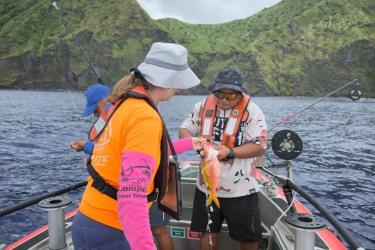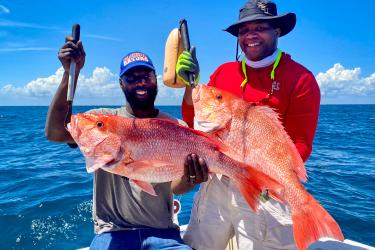In 2024, NOAA Fisheries funded several projects to restore habitat in collaboration with recreational anglers through the National Fish Habitat Partnership. Our partners have made considerable progress on this work, actively engaging local communities—including anglers—to conserve fish habitat. These projects demonstrate NOAA’s commitment to restoring fish habitat and supporting access to sustainable saltwater recreational fishing, a popular pastime that boosts the U.S. economy.
Community-Based Coral Restoration in West Oahu, Hawaiʻi
Sponsoring Partnership: Hawaiʻi Fish Habitat Partnership
Kuleana Coral Restoration has continued community-based coral restoration work to revitalize once abundant juvenile fish habitat at Pōkaʻi Bay. The project is sponsored by the Hawai’i Fish Habitat Partnership, in collaboration with Waianae-based community partners including Nā Kama Kai and Kingdom Pathways. With support from NOAA Fisheries, our partners planted more than 500 large rescued coral colonies and more than 700 coral fragments in two events. Monitoring previous projects shows that a smaller distance between coral outplants provides protection against rubble and debris during high wave conditions and minimizes predation. By employing this coral planting approach, community partners are creating more functional habitat for recreational and subsistence fisheries for jacks, snappers, surgeonfish, and parrot fish. They’re also ensuring coral fragments’ optimized survival.
Hook and Line Fishing Surveys in the Cascade Head Marine Reserve, Oregon
Sponsoring Partnership: Pacific Marine and Estuarine Partnership
With funding support from NOAA Fisheries, the Oregon Department of Fish and Wildlife Marine Reserves team collaborated with volunteer anglers to survey the Cascade Head Marine Reserve. The project is sponsored by the Pacific Marine and Estuarine Partnership. Providing scholarship opportunities to cover the cost of participation in the surveys (e.g., travel and lodging) allowed the team to expand volunteer participation across Oregon and beyond. On each trip, volunteer anglers fished rocky reef habitat in historic pre-determined sampling areas and caught more than 900 fish including black rockfish, lingcod, and kelp greenling. These data inform the long-term ecological monitoring of the Marine Reserve examining how fish catch, biomass, and size have changed over time in and outside the Marine Reserve. With an improved understanding of the Marine Reserve’s impact on fish populations, managers can better protect the most important fish habitat.
Marsh Restoration and Hands-On Learning in Charleston, South Carolina
Sponsoring Partnership: Southeast Aquatic Resources Partnership
South Carolina Department of Natural Resources is creating hands-on learning activities for students in South Carolina. They are developing lasting relationships with K-12 schools in the area, alternative learning institutions, and recreational crabbing and fishing professionals. In partnership with South Carolina Sea Grant, the Southeast Aquatic Resources Partnership, and NOAA Fisheries, this project is changing the way South Carolina Oyster Recycling and Enhancement Program educational activities are implemented while aligning with South Carolina state science standards.
For example, students constructed an oyster reef and planted marsh grass grown at their school to improve marsh habitat for recreationally important species like red drum, spotted seatrout, and blue crab. Students also learned how to catch crabs and fish with the help of Casual Crabbing with Tia and Affinity and Holy City Fishing Charters. These opportunities connect classroom lessons to hands-on student experience beyond the classroom. They create a more robust and healthy learning environment for all students while improving local fish habitat.





